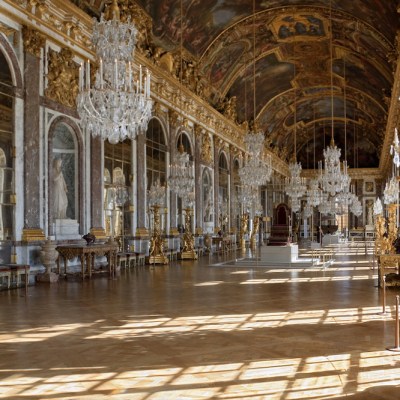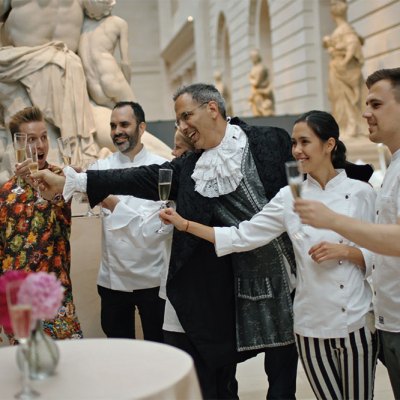From childbirth to death, the life of the monarch at Versailles was performed in public. That is one of the reasons Marie Antoinette created a separate life in her domain of the Petit Trianon, her refuge from court protocol. With its gardens and artificial lake edged by a higgledy-piggledy thatched-roofed hamlet, Trianon was designed to allow the young queen to ‘return to nature’, its working farm and dairy providing her with wholesome opportunities to educate her children, all in the spirit of Jean-Jacques Rousseau’s Enlightenment philosophy. Of course, though far less formal than Versailles, Trianon was nevertheless all design: its cottages’ rustic exteriors concealed richly decorated interiors in which the queen could entertain her friends. And it also contained her own private theatre. Marie Antoinette’s was an age in which ‘theatre-mania’ was rife, with small society theatres sprouting up within fashionable chateaux and stately homes. But at the same time stagecraft was still perceived as subversive and somewhat immoral, incurring the disapproval of the Church. Hence the recently restored Queen’s Theatre, as it’s known, housed within a somewhat featureless building between an artificial mountain and gardens, was conceived to be so understated from the exterior as to be hiding in plain sight.
The exterior of the theatre within the Petit Trianon domaine at Versailles. Photo: © Thomas Garnier

The inside of the theatre, a wondrous riot of cobalt-blue velvet and gilt acanthus garlands and friezes with nestling cherubs, is a different story. The theatre was built swiftly by Richard Mique (architect of the whole hamlet) in 1778–79, and it is interesting, in view of Marie Antoinette’s reputation for profligacy, to realise that its interior wasn’t fitted with the marble and bronze that later became the norm in opulent 19th-century theatres, but instead crafted from the same humble materials that were also used to shape stage props such as dragons, clouds and mountains. Thus the friezes and garlands that look like gilt wood are in fact papier-mâché and wire, while the golden statues that resemble bronze are actually made of wood, and much of the gilding was done with copper: it is all make-believe.
Marie Antoinette first stepped on to the stage of this other-worldly space as a performer in 1780. In so doing she expressed a special personal connection made in childhood: at the Austrian court, she had been taught French by tutors who were also actors, and for her French was therefore the language of the theatre, and the theatre a vehicle for the French language. Beyond this, acting offered Marie Antoinette, who was reluctant to play her actual role of queen, a means of escaping into role play with her first circle of friends, who also sang and acted. The queen’s was a modern playhouse in which modern works were performed: Rousseau’s Le devin du village, some opéras comiques by Gluck, her favourite composer, or Le barbier de Séville by the controversial playwright Beaumarchais. The queen often enjoyed playing the soubrette or the farmer’s wife and, with her aristocratic friends all on stage with her, would ask the servants of Trianon to sit in the auditorium and provide the claque, in a role reversal worthy of Marivaux’s comedies.
The interior’s gilt decorations are made primarily of papier-mâché, wire and wood. Photo: © Thomas Garnier

Marie Antoinette used her theatre only sparingly, between 1780 and 1785. In October 1789 she left Versailles for good, for Paris and then later on, the scaffold. During the sales that followed the Revolution, the Trianon theatre was not dismantled, protected by the modesty of its materials which, once seen for what they actually were, appeared entirely worthless. The space lay empty until Napoleon Bonaparte, who also liked the Petit Trianon, furnished some apartments there for himself in 1809 and took possession of the theatre, adding to its interior a neo-Roman imperial box in the shape of a military tent and some wallpaper adorned with his emblematic bees. Then came Louis-Philippe, who gave the theatre a new 19th-century red velvet interior complete with chandeliers, then Napoleon III and the Second Empire.
The theatre’s original 18th-century stage machinery. Photo: © Thomas Garnier

Yet the theatre remained very little used overall. ‘In many ways it was spared,’ explains Raphaël Masson, chief curator at Versailles, but by the end of the Great War it, like the rest of Versailles, had become sorely dilapidated. It was in the 1930s, thanks to donations from the United States, that a historical approach was taken to restoring it to something resembling Marie Antoinette’s original design. All 19th-century alterations were removed and the theatre was once again made blue. More recently, 18th-century albums of architectural drawings of the theatre were rediscovered in Italy and provided invaluable information about the original layout. It has also become apparent, Masson says, what the theatre’s hidden treasure is: the wonderful and still intact original machinery concealed beneath the stage, which allows the scene to change, while the audience looks on, from a forest glade to a rustic interior or a temple of Minerva through the use of pulleys and beautifully painted rolling panels. This is all still in working order and the Queen’s Theatre, one of the last theatres in the world of this kind, has become a museum space, too fragile to withstand more than very occasional performances.
The stage curtain during restoration, with a 19th-century forest backdrop painted by Pierre-Luc-Charles Cicéri and his workshop. Photo: © Didier Saulnier

What Masson calls ‘a period of 20th-century bricolage’, during which what remained of the original theatre was complemented by additions done in faux-18th-century style of the highest calibre, is ongoing today in the recent renovation of the space. This has entailed some technical adjustments. ‘Obviously we were hardly going to use acrylic,’ Masson says, when it came to repairing or reproducing the original décor’s peinture à la détrempe (an ancient technique of painting in which natural glue mixed with chalk is used as a base for the pigments). But the authentic blanc de plomb (which contains lead) that would have been used in the base had to be jettisoned. The process of restoration Masson describes has involved much trial and error in order to maintain the lightest touch when it came to updates, while labouring to recapture long-forgotten and precious ancient techniques.
The original 18th-century stage curtain – painted to imitate gold-embroidered blue velvet – which has been recreated as part of the restoration. Photo: © Didier Saulnier

Emblematic of this approach has been the remaking of the theatre’s stage curtain, which was completed in late 2020. Eighteenth-century drawings of the theatre showed this to have been a wondrous work of trompe-l’oeil, made of linen canvas painted to look like draped blue velvet richly adorned with gold embroidery. This was believed lost, and so Masson and his team attempted instead to repair a 19th-century rideau de manoeuvre, a curtain that was added under Louis-Philippe in order to conceal scene changes from the audience, to suit new conventions. Upon closer inspection, however, the Louis-Philippe curtain turned out to be a sort of palimpsest: the canvas was in fact the original 18th-century one, which had since the days of Marie Antoinette been reused at least twice. ‘It would have been boiled clean and then repainted,’ explains Masson.
However wonderful this historical discovery, the fabric was by now in such a parlous state that a decision was made to make a new curtain, an identical copy of what Marie Antoinette’s curtain would have looked like. A specialist craftsman painstakingly sewed the vertical panels of the curtain entirely by hand. ‘That’s why it hangs so perfectly,’ Masson explains. ‘It would have been hideous and ungainly if machine-made.’ Then the fabric was stretched out on to the stage and pinned into place so that the painters could walk over it when painting the trompe-l’oeil effects; the original curtain meanwhile was hung at the back of the stage, to serve as a model. In order to reproduce the curtain’s en clinquant ornamentation (made from gilded copper leaf to give the illusion of gold embroidery), an electric gadget used in contemporary Greece to decorate Easter eggs in the Orthodox tradition made possible the tricky task of maintaining the correct temperature for the hot wax and linseed mixture used to seal the metallic arabesques into place.
The reproduction trompe-l’oeil stage curtain. Photo: Thomas Garnier

Lighting was also carefully considered during the process. ‘We live in an age of excessive lighting,’ says Masson. ‘But in order to recapture the theatrical effects of merveilleux (wonder), we use lightbulbs that imitate candlelight. This is a place of illusion.’ The moment when, after weeks of work, Masson and his team sat down in the auditorium to see the new curtain hanging in place for the first time was, he says, a moving experience. ‘It had to be perfect,’ Masson says, adding: ‘If you can’t have perfection at Versailles, then where?’


